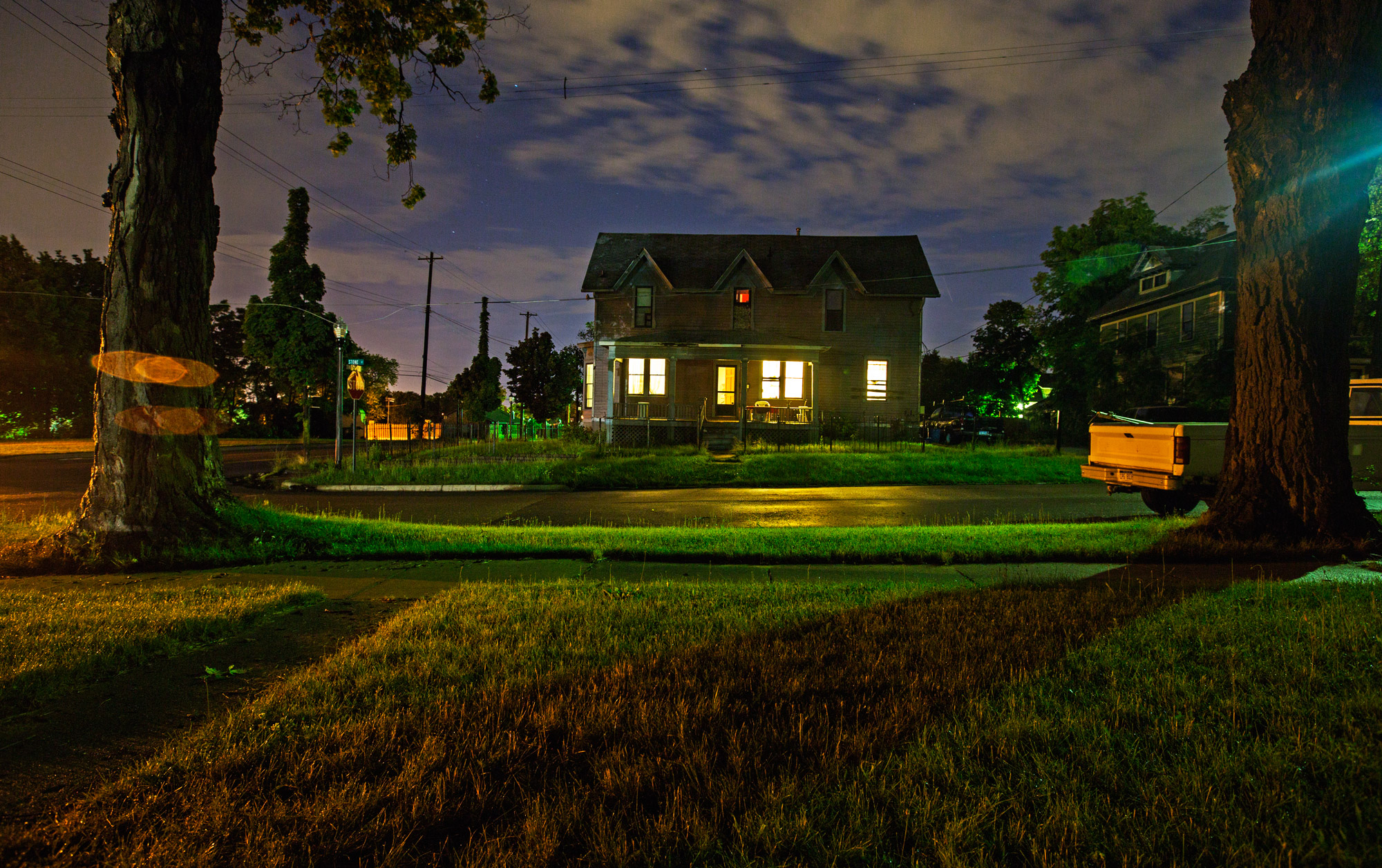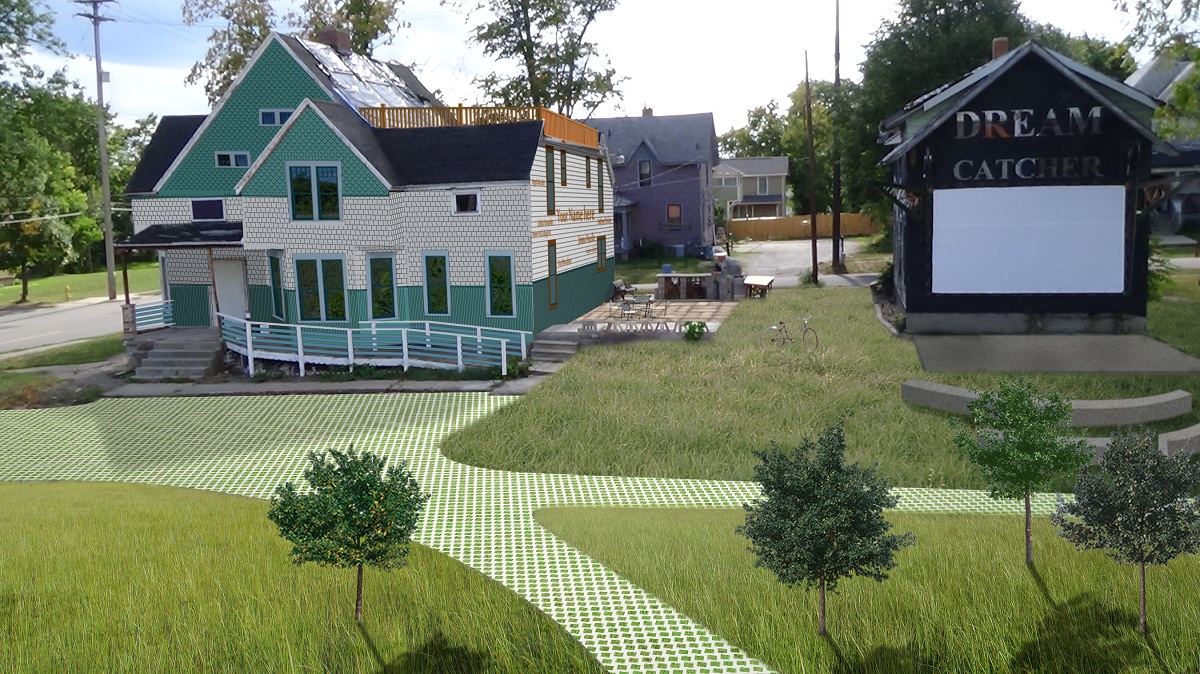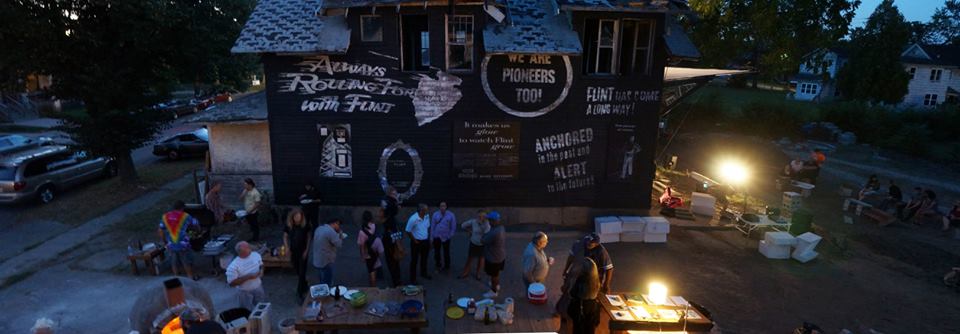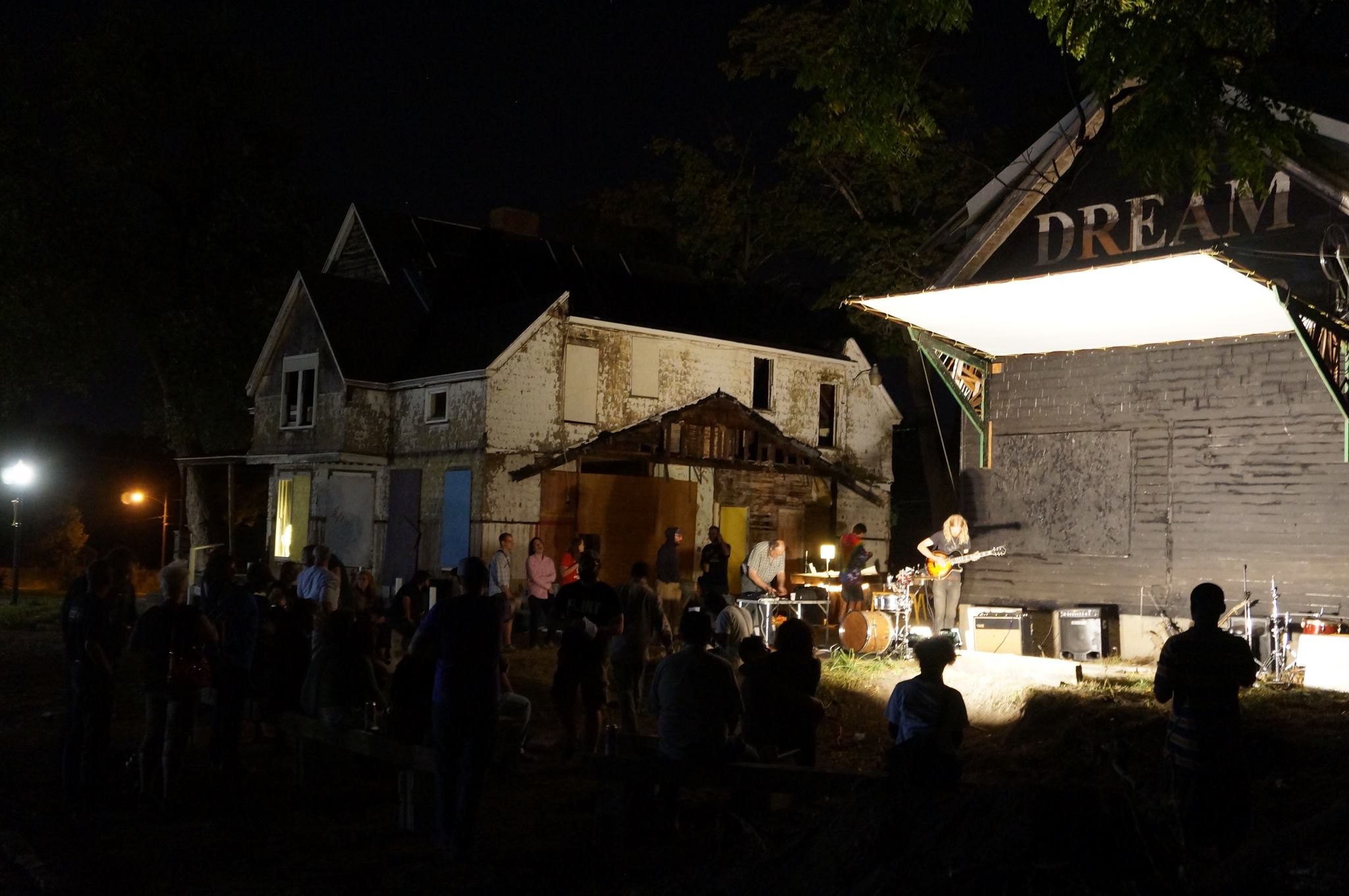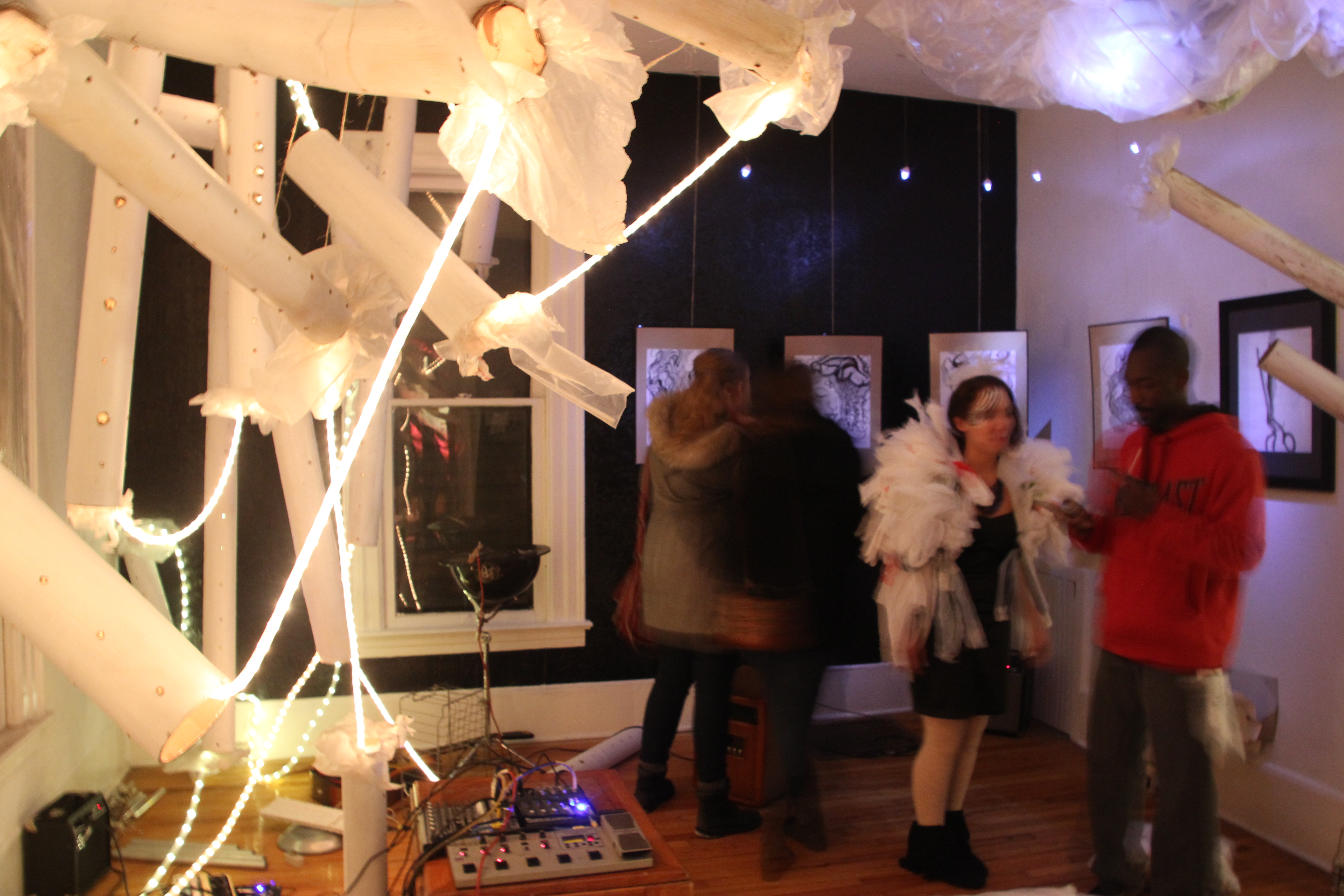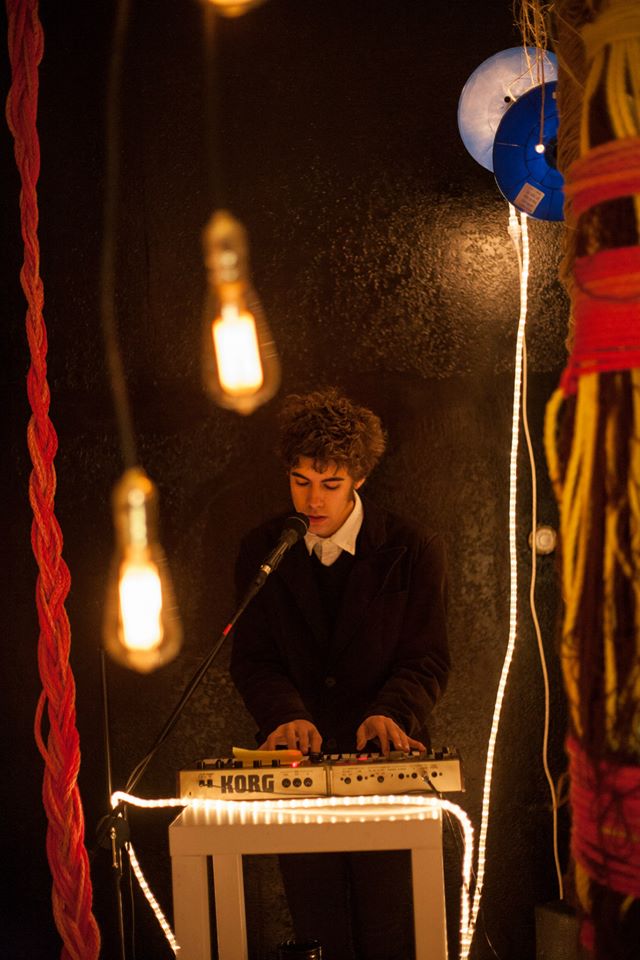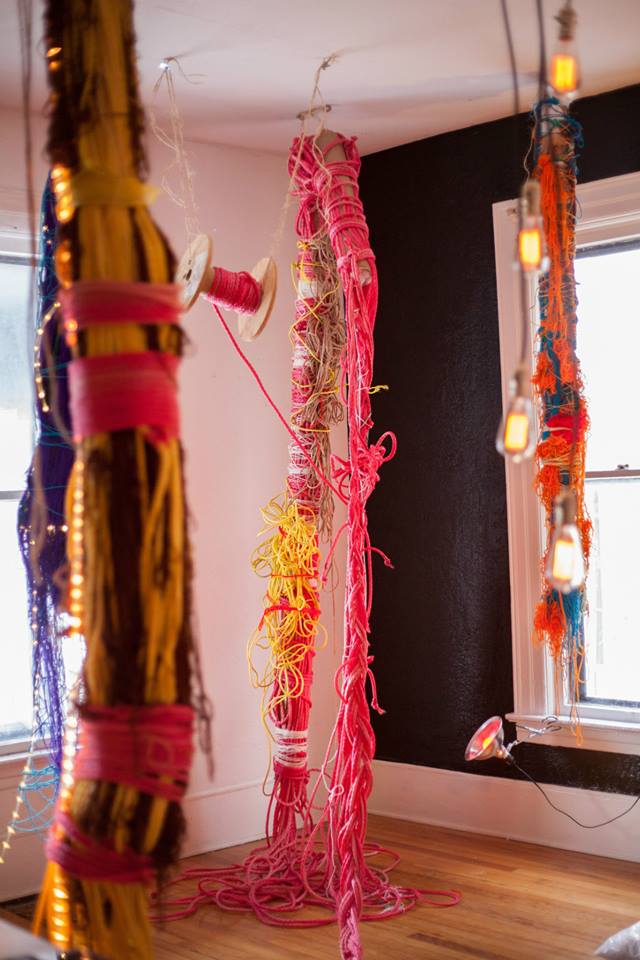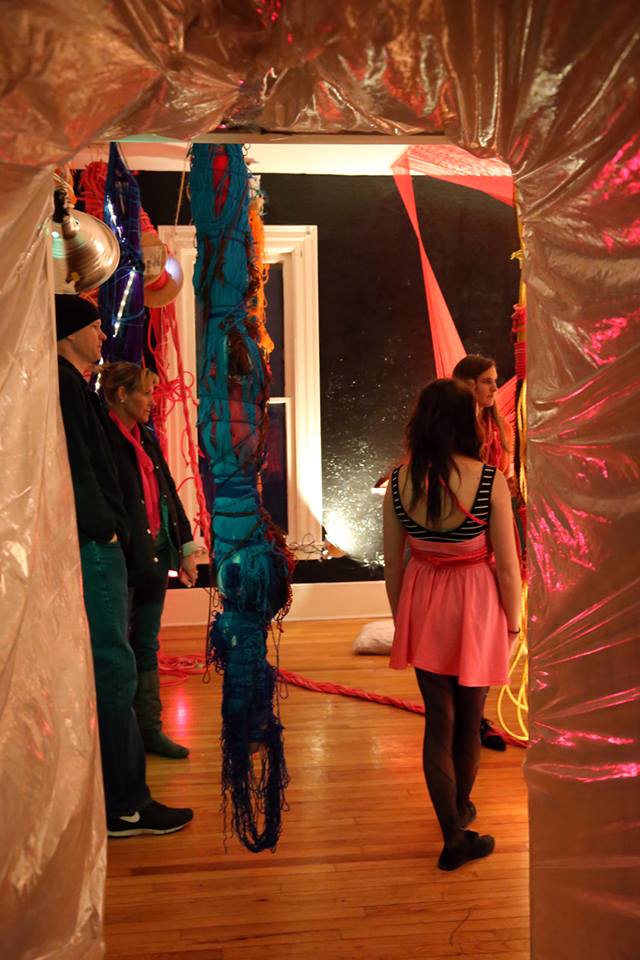By Matthew Morowitz
Spencer’s Art House. Photo courtesy of Enki Andrews.
Many people in the arts search for inspiration in exotic and far off places, however for Flint Public Art Project (FPAP) creating an innovative program required going no further than their own base of operations. FPAP acquired a property on Stone Street in the summer of 2012 and officially opened the Stone Street Residency program in October of the following year. The program provides “free or low-cost housing to artists, designers, community leaders, teachers, and others to pursue short-term projects in Flint, Michigan.” Recently, AiOP reached out to Stephen Zacks, Executive Director of FPAP, and Candice Stewart, co-founder of Unusual Operation Operation, a temporary alternative space on the ground floor of the house, about the program, what it has accomplished, and how it has changed since its inception.
What was the impetus behind starting the Stone Street Residency program?
STEPHEN ZACKS: In July 2012, Flint Public Art Project adopted a house across the street, the Spencer’s Art House, for an adaptive reuse project. Andrew Perkins, an M.Arch graduate of the School of Architecture and Planning in the University at Buffalo, worked for a year and a half on rescuing this beautiful 1890s home using reclaimed materials. Across the street, the Stone Street Residency is an amazing purple house with eight bedrooms. It was being sold by the Land Bank, which takes tax-foreclosed property in the city and resells it, loans it out for community gardens, or demolishes it if it can’t be saved. We bought it on a Land Contract, meaning we had to replace all of the scrapped electrical wires, plumbing, furnaces, etc. and do a certain amount of work to fix it up in order to take the title. We lived there and hosted invited artists and designers since that time.
Then we saw that a good way of making the house sustainable long-term and supporting art projects on underutilized property would be to turn it into a permanent residency, where local artists could live inexpensively while contributing to projects in the city, and visiting artists could live while collaborating with local organizations. We tore out a section of the living room wall to connect the two sides of the building, because the house was divided into four apartment units. Now it feels sort of like a student housing cooperative. It has a shared kitchen on the ground floor, and two of the former upstairs kitchens are now used as bedrooms.
A rendering of the Spencer’s Art House plan by Andrew Perkins
How has the program fared in the five months since it was started?
STEPHEN ZACKS: In January, Candice Stewart and Cinthia Montague, these really great Flint artists we have been collaborating with on projects for a long time, saw the opportunity to use one of the living rooms on the ground floor for a temporary art space. Thus was born Unusual Operation Operation. UOO really captures the spirit of Flint right now, where all of this space is available for people to use creatively. People buy whole blocks and turn them into community spaces and farming cooperatives, reuse fire stations for breweries, turn landmark schools into senior housing, and the historic business district has been restored to reflect its origins as the center of a town renowned in the early 1900s for horseless carriage manufacturing, and is filled with bars, restaurants, and modern offices. In 2013, we used a quarter-mile section of a demolished former factory site for large-scale open-air public art festival, and Stone Street belongs to the larger revitalization of the Carriage Town Historic District, where these handsome Victorian homes are painted bright colors and their detailed woodwork has been restored. The City of Flint has also undertaken a complete reworking of its vision for itself with the Imagine Flint master plan, which allows us to creatively rethink the shape of the entire city.
Spencer’s Art House opening. Photo courtesy of Stephen Zacks.
CANDICE STEWART: Many different artists have stayed at the residency that otherwise wouldn’t have had a reason to visit Flint, each bringing with them a new project in mind. Some have done pieces that are now permanent, and some did pieces that were temporary and caught the attention international press as well as Flint residents.
Spencer’s Art House opening. Photo courtesy of Stephen Zacks.
What changed? What remained the same?
STEPHEN ZACKS: The exciting thing now is seeing how the space it getting used by people who are bringing their own creativity to it. Ideally it’s a platform for them to do projects in the neighborhood and around the city. There are many other houses on Stone Street and in Carriage Town that we can adopt and experiment with.
Unusual Operation Operation, January show: BLACKANDLINE. Photo courtesy of Candice Stewart.
The house as a medium and space for contemporary art has an important history, including works like Gordon Matta-Clark’s famous Splitting project in 1974, and earlier, the adaptive reuse of commercial buildings by architects like Richard Meier, who took the former Bell Labs building in Greenwich Village in 1967 and turned it into the Westbeth Artists’ Housing, where 384 apartments were created out of 17 scientific laboratory buildings. George Maciunas’s 1963 Fluxhouse Plan for an Artist Condominium in New York City is an essential reference point, a plan for artists to live illegally in Soho factory buildings, which fundamentally changed the laws governing housing in New York and eventually became standardized in the building code for reuse of commercial buildings in the U.S.
Since then Detroit has become a center for these types of experiments, so it’s an exciting time in that sense. People like Mike Kelley, before his tragic death two years ago, used a house traveling across Michigan Avenue on a trailer as a metaphor of the dislocation and reconnection of people to places.
Before now, our project was theoretical, looking at these historical models and contemporary examples as inspiration. Now it’s happening—we have the opportunity to contribute to these transformations underway, and to help make them visible.
Unusual Operation Operation, January show: BLACKANDLINE. Photo courtesy of Candice Stewart.
Tell me about some of the past residencies that went through it?
CANDICE STEWART: There have been a few really awesome people who have gone through, going back to before Stone Street was officially turned into a residency. One who had a very special project was Andrew Perkins. He started what is now called the Spencer Art House, a former mortuary that was left to rot away in the 1990s. He put a ton of work into bringing it back to life again with plans on becoming an artist residency and design laboratory. Using all reclaimed materials and minimum funding, he managed to build a new foundation wall, installed an outdoor projection screen and stage canopy and also began installing a 2,000 gallon rainwater collection system…just to name off a few. The space has hosted quite a few community events and it’s not even finished yet, so we’re excited to see what new opportunities it will bring when it’s ready to house new artists.
Unusual Operation Operation, January show: BLACKANDLINE. Photo courtesy of Candice Stewart.
Tell me about the present one?
CANDICE STEWART: There are a few things going on at the residency right now. A few musicians are here and it’s always a treat to walk into the house and hear people singing and playing the piano…that never gets old! A couple of them are working on recording an album and have been playing at a lot of our local venues.
Also, my colleague Cinthia Montague and I work together on projects as a collaborative team, Stewart//Montague. In January, we took over one of the living rooms in the house and made it into an alternative art space that we named Unusual Operation Operation. Our first show, BLACKANDLINE featured an installation by Stewart//Montague, line drawings by local artist Tamra Klaty, an electronic sound performance by Ryan Gregory, Hannah Kovalchek and Aaron Griffin, and artisan hors d’oeuvres by local chef Christopher Reynolds.
Unusual Operation Operation, February show: STRING. Photo courtesy of Stephen Zacks.
We weren’t really sure what to expect–we had just created a new space in nearly two weeks–but it ended up being a pretty successful event with about 60 people coming to check it out. For the second month, we collaborated with Lindsay Decker and Cameron Winn, as well as Brooke Vander Gronden on installations using string as a medium, with tantalizing Indian cuisine by Lekha Rock and a sound performance by Stone Street resident Tyler Rigdon.
We spend a lot of our time there, planning shows and organizing other events. We opened the space in effort to promote the residency, so people are free to come check out the space and also be our guests for the opening of monthly exhibitions.
Have any been decided on for the future?
CANDICE STEWART: Applications are now being accepted! You can read more about it at: http://flintpublicartproject.com/fpap-programs/stone-street-residency/
Unusual Operation Operation, February show: STRING. Photo courtesy of Lindsay Decker.
What effect has this program had on the greater Flint area?
CANDICE STEWART: This is very different for the Flint area, and it’s definitely captured a lot of interest. With the never-ending changes in automotive production, Flint has been adapting and finding its way back into the sunlight for other reasons, and the arts have played a big part in that. People watched Andrew with his big project, taking a collapsed building, much like Flint itself, and re-envisioning it as something beautiful…people took note of that, and I think it has started to give a sense of hope. The opportunity is here. More community events are taking place, artists are producing new projects, and if you’re inside the residency, there is singing in the air.
Unusual Operation Operation, February show: STRING. Photo courtesy of Dustin M. Price.
More information about and applications for the program can also be found here.

